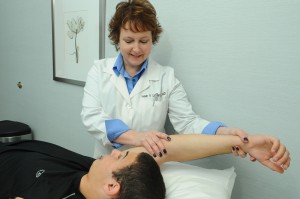The month of October makes most people think of pumpkin spice lattes, vibrant leaves, and Halloween costumes. But here at Premier Orthopaedics, we have something else we keep an eye out for, too, because it's also the time of year known as National Spine Health...
LATEST BLOGS
September is National Vascular Disease Awareness Month
As September starts, it's National Vascular Disease Awareness Month. This is a great time to learn about the health of our veins and arteries. Vascular diseases include problems like deep vein thrombosis and peripheral arterial disease. Read on to learn how to keep...
Causes & Treatment Options for Sciatica
Pain that starts in the lower back and radiates down the back of the leg is what is commonly referred to as sciatica. The pain follows the path of the sciatic nerve down the leg which means that typically, only one side of the body is affected. The sensation that...
Physical Therapy for Shoulder Surgery

Physical therapy is an integral part of shoulder treatment involving surgery. Physical therapy is done both before the surgery (pre-habilitation), and after surgery (post habilitation). Though not prevalent some years ago, the benefits of pre-hab are increasingly recognized in treatments involving surgeries.
Physical therapy for shoulder surgery during pre-hab is meant to increase the rate of recovery after surgery. However, since one is already injured, the exercises devised should not be too strenuous on the shoulder joint. This is because it can lead to more damage being inflicted on the affected shoulder. Pre-hab should start 6-weeks before surgery. If one can start earlier then it is even better as it leads to better results.
During this phase, the biggest risk is overuse of the shoulder joint or over training. Both result in a large strain being placed on the injured arm which may make the injury worse. Those who would argue that if there is a risk of making the injury worse during pre-hab should keep in mind the fact that people who have undergone pre-hab recover much faster and require less around-the-clock care after surgery compared to those who only undergo post-surgery rehab.
Pre-hab exercises are designed to keep the shoulder supple, strong and flexible while at the same time ensuring that more damage is not caused. This could include various range of motion exercises and using one’s arm weight to exercise. Exercises that strain the shoulder greatly such as weight training should be avoided.
After surgery, physical therapy is important to ensure that one heals fully, correctly and fast. A few days after surgery, one will normally exercise their arm while ensuring that the shoulder that was operated on is not moving. This includes flexing the wrist and the elbow and pendulums. Pendulums involve dangling one’s arm and using one’s body weight to swing the arm back and forth. At this stage, care should be taken to ensure that movement is not generated by the shoulder as it can cause tearing.
A few days after the surgery, physical therapy moves on to the next stage, passive movement. Passive movement is meant to keep the shoulder supple and flexible during the healing process. During passive movement, the arm will be moved by a nurse or a machine.
At around the 5th or 6th week, the shoulder is sufficiently healed to allow it to move without a high risk of causing damage. It involves moving the shoulder joint in different angles gradually until near optimal range of motion is recovered. Strength training is also included in this phase. One typically has to support the shoulder initial until it becomes more supple and strong. At this stage, free weights and elastic bands are used for strength training.
In about 4 months, one is usually fully recovered and can do more strenuous strength training exercises such as push-ups as well as participate in sports. One should however avoid contact spots such as football and rugby until they are truly recovered.
The thing to keep in mind when undergoing physical therapy for shoulder surgery is patience and rest are as important as the physical therapy itself, if not more important. Trying to do too much too soon could be detrimental to one’s recovery progress.
Doing the correct exercises at the correct time is also very crucial. Where one can easily search the net and find lots of articles dealing with physical therapy for shoulder surgery, it is no substitute for seeking professional help and opinion. Thus before embarking on any physical therapy, it is best to talk to an orthopaedic professional, a physiotherapist or a doctor. For more information contact Premier Orthopaedics.


